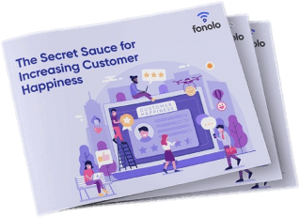Customer perception has never mattered more. In the age of social media backlash and call-out culture, how your customers feel about your brand is key to your success. Although it’s almost impossible to completely control what people think about your organization, improving customer opinions of your brand is very possible. Here’s your complete guide to improving customer perception of your business.
What is Customer Perception?
Customer perception describes the way your customers think and feel about your company. It’s the beliefs and opinions that people hold about your business.

Sometimes, public perception of a whole industry can change — we’ve seen this recently with dairy, cereals, and meat-free alternatives. These are typically generational trends caused by new technology or information about a product.
Why is Customer Perception Important?
Businesses care about customer perception because it directly impacts their bottom line. A negative turn in customer opinion may not destroy your business, but it will almost certainly lead to lost revenue, market share, and reputation.
Salesforce reports that a staggering 84% of customers say the experience a company provides is at least as important as its products or services.
How customers perceive your brand is essential to your success. If you're not investing in improving your customer’s perception of your business, you're going to be left behind. #BrandPerception #CustomerPerception Click To TweetIt boils down to this: if you’re not investing in improving your customer’s perception of your business, you’re going to be left behind.
Does Customer Perception Matter to Small Brands, Too?
Customer perception is even more important for small businesses because, when something goes wrong, larger corporations can usually absorb the costs from a PR disaster. Smaller businesses often struggle to do this.
That said, small businesses do have an advantage in their ability to respond to the negative perceptions. It’s one of the reasons why responding to bad reviews — and resolving them — can have such a positive impact. People are willing to forgive brands for making mistakes and want to support local brands. Just make sure you fix your mistakes!
4 Ways Your Employees Impact Customer Perception
Billionaire entrepreneur Richard Branson once said: “I have always believed that the way you treat your employees is the way they will treat your customers.”
We couldn’t agree more.
We’ve probably all experienced something like this: an encounter with an employee that was so negative that it makes us decide to take our business elsewhere in future. This moment of truth determines how we think and feel about that brand. Second chances are unlikely.
Over the last few decades, many researchers have proven this link between employee behavior, customer satisfaction and the monetary cost of toxic employees. Here are four concrete ways employees impact your brand’s customer perception.
1. How they approach customer problems
The way that your employees approach solving a customer’s problems helps determine how that customer will perceive your brand. Here at Fonolo, we love hearing from our happy customers that we spotted a problem before they did. This is the best way to prevent damage and creates a very personal, attentive service.
The best way to approach customer service is to be proactive: solve a problem before a customer notices and their respect and appreciation of your brand will get a massive boost.
Customers don’t want to call you in the first place. They definitely don’t want to call you twice. If you’re proactive about solving problems, your customers will perceive you as a brand that cares and whose employees are highly competent and engaged.
2. Their attitude and manners
Your energy introduces you before you say a word. If your employees are rude, surly, or impolite, that’s how customers will perceive your brand.
That doesn’t just include the words your employees use to address customers; it’s everything about how they handle themselves. It’s human nature to like people who are nice to us — and human nature is really what customer perception is all about.
3. How they approach upselling opportunities
Upselling is something that all your customer-facing employees should be doing — not just sales. Each customer interaction is an opportunity to solve a problem and provide extra value, but too many employees let this opportunity slip past.
The best employees don’t push random, irrelevant products. And they don’t get irritable when the customer says no. Teach your employees to actively listen to your customers and look for opportunities to genuinely solve problems with your products.
4. Happier employees make happier customers
One of the most prolific findings across our research was this: when your employees are content, your customers will be satisfied too. It’s one reason why successful companies focus on the extra-curricular perks and benefits they give to employees.
Hospitality firms (think Disney or Ritz-Carlton) are masters at turning mundane customer service encounters into memorable experiences that nurture customer loyalty. And if you want your employees to help you improve customer perception of your brand, you have to start with them.
If your employees are happy, your customers will be happy too. Click To TweetTraining your employees properly and empowering them to solve customer’s problems on their own will go a long way to help improving customer perceptions.
Even more important, though, is creating a pleasant workplace, with cheerful colleagues, where people have enough time to do their work and feel valued for it.
It is impossible to control exactly how your employees communicate with your customers. ” the best and most efficient thing to do is to ensure that your employees are content — and happy customers will follow.
How to Manage Customer Perception
Managing customer perceptions and expectations is essential to successfully running a customer service department. To make things simpler, we’re going to focus on these three main determinants of customer perception and how to positively impact them.
- Personal Experience
- Marketing and Advertising
- Word of Mouth and Social Cues
1. Personal Experience
The most important factor determining customers’ perceptions is their experience with your brand. This includes the quality and consistency of the service they receive, and the value that they feel that they get from your product.
Everything from your product itself, to brand voice and color will impact how customers feel about your brand. And the customer journey doesn’t end when you make the sale; your level of service post-sale is as (if not more) important than pre-sale.
Factors that influence customers’ personal experience with your brand:
- Price: Price is, of course, key in consumer decision-making but is not as important as you may think. And lower is not always better. You need to carefully price your products to reflect how you want customers to perceive them. Are they cheap-and-cheerful or high-end luxury?
- Quality: Quality is difficult to define and can apply to various aspects of your company. The perception of quality will vary from customer to customer. The key is determining which factors your target customer base perceives as the most important.
- Level of Service: How you treat your customers pre- and post-sale plays a large part in whether they come back. Everybody likes to be treated with respect — especially when parting with their cash.
2. Marketing and Advertising
Marketing is part of the customer experience, but it also includes your wider public image. Marketing allows you to influence how non-customers perceive your company too.
Factors impacting your brand’s marketing influence:
- Branding: Branding is an incredibly powerful tool for influencing public perception. Color, tone of voice, even store decoration and packaging can heavily influence how people perceive your brand. When choosing your brand colors, it’s important to remember the pre-existing associations that people have with things like color and font.
- The Power of Association: Something like a Super Bowl ad can quickly establish a brand as a big player, and therefore ‘more trustworthy’ very quickly. And things like sponsoring sporting events form associations in consumers’ minds. Red Bull has used sports sponsorship to cement its place as an extreme sports brand very effectively over the last decade. And cozying up to a sports team or an ‘influencer’ in your niche can quickly win you fans of your own by proxy.
3. Word of Mouth and Social Cues
It’s the hardest to measure but word of mouth is an incredibly important factor in how customers perceive your brand — especially if you have a small business.

We often think of word of mouth in the literal sense but these days it’s far more: customer reviews, social media, and micro-blogs are all word of mouth too. Components of word of mouth influence include:
- Online Reviews: Customer reviews on your site or elsewhere offer a great opportunity to positively influence customer perceptions. When people see you resolving issues online, it cements a strong impression and builds trust. The same goes for the content that people see about your brand on blogs and social media. The most consistent message will be the one that people base their opinion on.
- Social Media: Before the internet, the only way of finding out what people thought was to ask them directly. But online reviews, blogs, and social media give us the opportunity to learn about and sway public perceptions on a much wider scale. It also gives other people the opportunity to influence consumer perceptions of your brand.
Influencer marketing has become so popular because we’re social animals. If everyone in your community — the people we see every day — is raving about a product, you’re probably going to borrow their opinion, whether you use the product or not.
A Word About Demographics
Demographics also play a big part in customer behavior and it directly impact customer brand perception. If consumers perceive that a company only caters to a certain type of clientele — and they’re not it — they’re unlikely to use that brand for fear of feeling out of place. This is why luxury brands are so selective about their customers. Keep this in mind when interacting with your customers and sharing on social media.
5 Ways to Improve Customers’ Perception of Your Company
Improving how customers perceive your brand is a complicated and lifelong task. And sometimes, no matter how hard you try, things can happen that instantly change how the world perceives you. Still, if you honestly try your best to deliver a great product or service, your efforts will pay off. Here are some things you should think about if you want to improve how customers regard your brand:
Create an awesome customer experience
Creating a great experience for your customers is the core of creating good customer perception. Most of the bad things we think about brands come from things that have happened to us, or to others, while interacting with a brand. Strive to create an experience and product that people want to boast to their friends about. And support it with world-class customer service.
Strive for consistency
Besides consistency in your customer experience, it’s important to create a consistent image of your brand. Inconsistency will breed distrust. Create brand values that leave no room for misunderstanding about how customers and their problems are treated.
Listen to your customers
We’ll dive into this in-depth below, but actively listening to your customers is essential to creating a positive brand image. When people are talking about their issue with your company, view it as an opportunity to improve, rather than something you need to ‘make go away.’
Forge emotional bonds with customers
Striking a chord emotionally with your audience will win you customers for life. Active listening is key to forming close customer relationships. You need to understand the motivations and deeper goals of your customers on an emotional level.
People don’t buy a new car because they want something to get them around. They buy a new car to feel more powerful or to better protect their family.
Understanding what customers mean when they say something like, “This feature makes me feel safe,” is key to understanding your target audience and their perceptions of your brand.
Communicate better internally
This is an often-overlooked key issue for bigger, complex businesses such as airlines. Data silos — where customer data is limited to one group within a company — can form because of security restrictions or poor communication. These are a major cause of frustration for customers.
Breaking down silos to ensure that customers have seamless interactions with your company is an easy way to cement your brand as “organized and competent” in customers’ minds.
How Do You Measure Customer Perception of Your Business?
Measuring customer perception is tough because it involves both subjective and qualitative data. It requires some nuance in your collection and analysis.
There are two main ways of finding out how customers perceive your business:
- Ask them
- Listen to them
Ask them with a survey
This is the tried and tested method, and I would encourage all brands to have some sort of customer satisfaction or net promoter score survey. These help you to gather specific, qualitative information about your CX and can provide some useful actionable metrics. We have much more detailed information about surveying later in this blog.
Listen to what they say when they call you
This is a very rich but frequently overlooked way of gathering customer perception data. Every time a customer contacts you, it is an opportunity to find out how they feel about your brand. This includes reviews that customers leave as well as times they contact you directly with an issue.
I’m talking about an active listening approach. Train agents to take notes on the ways customers talk about their experience.
Better still, automate it: Track customer sentiment score based on the language and tone a customer uses while they’re talking to an agent.
What is Social Listening, and How Do You Do It?
The other way of ‘listening’ available to brands is listening to online chatter. This is called ‘social listening’ and there are two basic ways to do it:
Monitor social media
People are talking about your brand all the time on social media — at least 2 million negative comments are posted about brands on social media every day. Many people will look to social media to get another angle on what people think of a brand before deciding on a purchase. Marketing software like HubSpot, and onboard tools on many social platforms can help you keep track of who’s talking about you online.
Make sure you respond to direct messages and service requests on social media quickly and carefully because everyone can see what you’re doing. And don’t forget to get involved in conversations that are happening about your brand too. It’s not rude to weigh in if you have something positive to say.
Track mentions in publications
People don’t just talk about you on social media, they also talk about you in their own blogs, news articles, and other online publications. And — impossible as it may sound — there are plenty of ways to find out when this happens, most notably, Google Alerts.
Put in your brand name and any other keywords you think people will use when talking about you, click “create alert”, and Google will notify you when someone posts something online. You can use this to resolve customer service complaints that have been missed — and even create brand evangelists.
Best Practices for Creating Customer Perception Surveys
The key to creating a great customer perception survey is to figure out what you want to know about your customers. Then, look for opportunities in your customer journey to ask simple questions that give you contextual feedback. And don’t forget to follow up!

Defining your goals is the key to successful research. Here are some other general best practices to keep in mind while creating your survey:
- Keep it short and simple
- Ask questions that categorize customers
- Discourage neutral answers
- Limit open-ended questions
- Experiment with asking questions in different ways
- Test your timing
- Continually evaluate your survey effectiveness
- Follow up and respond with action
5 Types of Questions to Use on Your Customer Perception Survey
Regardless of the type of survey you create, the types of questions on them will be similar. Make sure you take advantage of all of them. They can be broken down into four categories:
1. Binary Questions
These are the simplest questions in your survey. These questions can be answered with yes or no.
Some examples of binary questions:
- “Did you find the answer you were looking for?”
- “Was your issue resolved today?”
- “Would you recommend this product or service to a friend?”
These are useful because of their simplicity. They’re a very effective way of finding out whether you’re meeting expectations after an interaction with a customer.
2. Multiple-Choice Questions
Multiple-choice questions are most useful for gathering categorial information about your customers. This helps you to categorize your audience and gives you useful ways to slice your data when analyzing.
The answers offered to customers in a multiple-choice question will typically be chosen based on the buyer personas and market segments the business is targeting.
Some examples of multiple-choice questions:
- “What’s your seniority level?”
- “How many people work at your company?”
- “What industry do you work in?”
3. Sliding Scale Questions
These are the questions that you most commonly think of in a customer satisfaction survey. They’ve become an industry standard, which helps because customers know how to answer them quickly. They’re great for finding your own benchmarks and can be used to segment your data very easily.
Another benefit is that you can use responses to trigger certain actions, such as a follow-up email or phone call.
An example of a sliding scale question would be the classic CSAT question:
- “On a scale from 1 to 5, how satisfied are you with your experience?”
- Very Dissatisfied 1 – – – 2 – – – 3 – – – 4 – – – 5 Very Satisfied
Some variants of this question use phrases instead of numbers to make it easier for customers to answer.
4. Semantic Differential Questions
Semantic differential questions are slightly different. They take a binary question and place it on a scale to help the customer pick an answer that accurately reflects their experience.
An example of a semantic differential scale question would be:
- “How expensive is X product? Make a mark on this scale that reflects your opinion:”
- INEXPENSIVE – – – – – – – – – – – – – VERY EXPENSIVE
Although they can help you with relational questions, very often, you will end up with similar responses to a binary question.
5. Open-Ended Questions
This final question type allows us to collect the most valuable type of information for the brand perception researcher: qualitative data.
Qualitative customer feedback is essential. It helps you address problems in your customer journey, and it’s also a great resource for informing your marketing and product design too.
TIP:
You can give customers the opportunity to express their feelings in an open-ended question that is related to a binary or scale question. But make these fields optional. If you require this type of answer to complete the survey, customers are likely to abandon it before finishing.
Top Questions to Ask on Your Customer Perception Survey
Here are some of the top questions to ask in your customer perception survey:
Customer Experience-Based Questions
All these questions will help you to get a complete picture of your customer journey and how customers perceive their experience with your brand:
- “How likely are you to recommend us to a friend?”
- “How satisfied were you with your experience?”
- “How easy was it for you to resolve your issue?”
- “How would you rate the quality of support you received?”
- “Please share some details about your experience.”
- “Please let us know how we could have made your experience better.”
- “How does this experience compare to your experience with similar brands?”
Brand Perception Questions
- “How familiar are you with this brand?”
- “How trustworthy is this brand?”
- “How likely are you to purchase a product from this brand?”
- “What’s the first thing that comes to mind when you think of this brand?”
- “How would you describe your overall opinion of this brand?”
- “Please share some details about why you feel this way about this brand.”
- “Is Brand X more or less {expensive/popular/quality/fun} than Brand Y?”
Demographic Questions
Make sure you include these too! Demographic questions are questions on things like:
- Age
- Gender
- Race
- Job
- Education
- Location
Although they’re not going to tell you what customers think, they will help you find correlations between groups of people that feel a certain way about your brand — and give you clues as to why they feel that way.
While quantitative data is great for quick, definitive answers it doesn't tell you 'why' customers hold that opinion. You need qualitative data too. Click To TweetWhen to Send Customer Perception Surveys
Timing is everything with customer perception surveys. You want to make sure you’re regularly getting customer feedback, but you don’t want to spam them with surveys. Here are the best times to send out a customer satisfaction survey.
1. Immediately after an interaction with a customer.
These are often missed opportunities to capture the full picture of your customer’s perceptions. Consider including a short, binary or NPS-style scale in these places:
- At the end of emails
- On receipts
- After customer sales calls
- At the bottom of self-help articles
2. After the customer has completed a transaction.
Once a customer has made a purchase, follow up to get feedback on how they viewed the experience. The length of time you might wait before contacting them will depend on your product; be sure to give them enough time to fully digest the product and experience.
A travel firm will send you a survey after you’ve booked, as well as after you’ve returned from your trip.
Orthodontists or laser eye surgeons are more likely to get your feedback quite soon after the procedure is complete when the “wow” factor is still present.
3. At pre-determined stages of the customer lifecycle.
You can also time your surveys to measure how customer perceptions change through the customer journey.
These are particularly useful for brands that have a long buying cycle, use brand ambassadors, or rely on content publishing. The aim is to determine how customer perceptions change at each different stage in the customer lifecycle as well as what can be done to influence them.

The Secret Sauce for Customer Happiness
Learn the key ingredients for making customer happiness the forefront of every business interaction.

